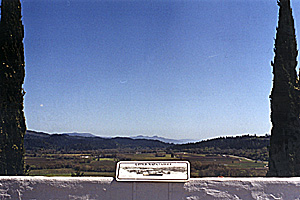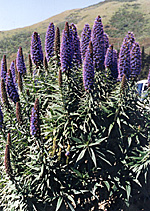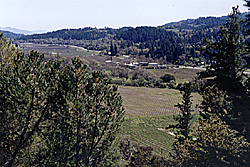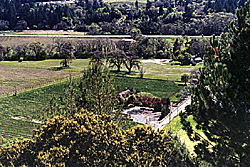 In a region known for its wine, a pair of historical museums might merit a stop in between all the wineries. They are not large--indeed, you can go through each in about a half an hour, but it will give your head a chance to clear if you imbibe too much.
In a region known for its wine, a pair of historical museums might merit a stop in between all the wineries. They are not large--indeed, you can go through each in about a half an hour, but it will give your head a chance to clear if you imbibe too much.
At right, the upper Napa Valley (looking south from Stirling Winery, Calistoga, CA)
The Napa Valley is home to over 300 wineries, and just about every one is open for tasting. Over five million tourists flock to the area each year, and the single-lane-in-each-direction Route 29 must become crowded indeed at the height of tourist season. Fortunately, we went in mid-April when the crowds are thin, wineries virtually empty, and museums are empty. We did a day trip from San Francisco. Napa is about 50 miles away, or about an hour to an hour and a half north. We recommend crossing the Golden Gate Bridge on Route 101, hang a right at the cutoff to Vallejo and go until you reach Route 29. You'll drive through a marshland where egrets and ducks stop (at least in April). On the way back, use the 121 cutoff and drive back through the rolling ranchland.
The Napa Valley was inhabited by the Wapoo Indians, at least until 1823 when father Jose Altimira wandered by in search for a site for a mission (placed in Sonoma).
Napa was settled in the 1836 by George Yount, who received a land grant from General Mariano Vallejo. Although starting with only a few grapes, Yount eventually planted over 11,000 acres of grapes in what is now Yountville.
In 1858, a German immigrant named Charles Krug began a wine business [now Mondavi wines] nearby, which coincided with a silver strike in nearby mountains, followed by a cinnabar (or quicksilver) strike.
At right, Napa Valley vinyards
Winery fortunes continued to ebb, until by 1960, only 25 wineries were in operation, when wine organizations begin to promote the valley and its wineries. By 1990, over 200 wineries were in operation and tourism became the primary goal of the area.
We ate lunch at a local Deli and Pizzeria called Nicola's, also on Lincoln. Service is fast and friendly, the menu varied, and the "Deli Taco" (a huge bowl filled with chips, bean dip, lettuce, tomatoes, sour cream, and other goodies we would call a Taco Salad) is recommended.
More Napa Valley
This article appears in MagWeb (Magazine Web) on the Internet World Wide Web.Napa Valley History
 The entire valley--or at least the main part for wine-tasting tourists, is about 26 miles long, from Napa to Yountsville to St. Helena to Calistoga. We drove the entire length first without stopping, merely looking at the grapelands and getting an idea about which winery would look interesting to tour. And there are plenty to choose from, from the large and famous to the small and obscure. Not every winery has a tour, but all seem to have signs out saying "Tasting Today" or some such advertising. Most are open from 9am to 5pm and you don't need reservations.
The entire valley--or at least the main part for wine-tasting tourists, is about 26 miles long, from Napa to Yountsville to St. Helena to Calistoga. We drove the entire length first without stopping, merely looking at the grapelands and getting an idea about which winery would look interesting to tour. And there are plenty to choose from, from the large and famous to the small and obscure. Not every winery has a tour, but all seem to have signs out saying "Tasting Today" or some such advertising. Most are open from 9am to 5pm and you don't need reservations.
 In 1876, the Beringer Winery was founded. By 1890, over 140 wineries were in operation, causing prices to plummet due to the surplus of grapes. A variety of bugs and infestations plagued the valley through the end of the century, and trade plummeted with the beginning of Prohibition in 1919 (repealed in 1933).
In 1876, the Beringer Winery was founded. By 1890, over 140 wineries were in operation, causing prices to plummet due to the surplus of grapes. A variety of bugs and infestations plagued the valley through the end of the century, and trade plummeted with the beginning of Prohibition in 1919 (repealed in 1933).
 At Calistoga, the first place you should go is the Chamber of Commerce, which runs a small building off of the main drag, Lincoln Ave. It's a bit tricky to find. We walked into the local fire department (which we mistakenly thought was City Hall) and asked for directions. The Chamber is behind the hardware store. There is a sign, but you might not see it. If you get to the airport, you're too far. A wide variety of pamplets, maps, and other tourist information is handy, and the staff is cheerful and helpful.
At Calistoga, the first place you should go is the Chamber of Commerce, which runs a small building off of the main drag, Lincoln Ave. It's a bit tricky to find. We walked into the local fire department (which we mistakenly thought was City Hall) and asked for directions. The Chamber is behind the hardware store. There is a sign, but you might not see it. If you get to the airport, you're too far. A wide variety of pamplets, maps, and other tourist information is handy, and the staff is cheerful and helpful.
Napa Valley (Calistoga, CA, USA)
Sharpsteen Museum and Brannan Cottage (Calistoga, CA, USA)
Napa Valley Museum (Napa Valley, CA, USA)
Stonegate, Sterling, and Beringer Wineries (Napa Valley, CA, USA)
Back to List of Historical Sites
Back to Travel Master List
Back to MagWeb Master List of Magazines
© Copyright 1999 by Coalition Web, Inc.
Other military history articles and gaming articles are available at http://www.magweb.com